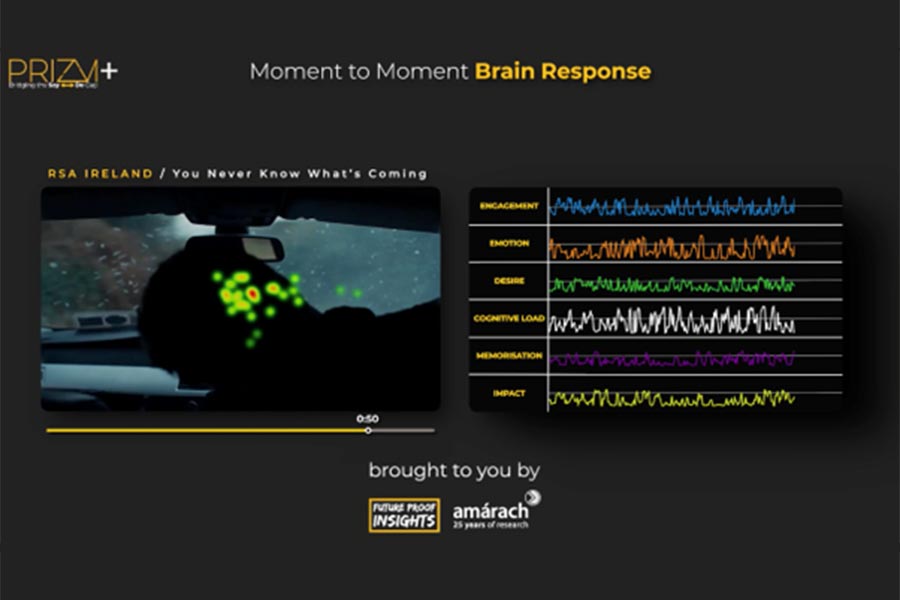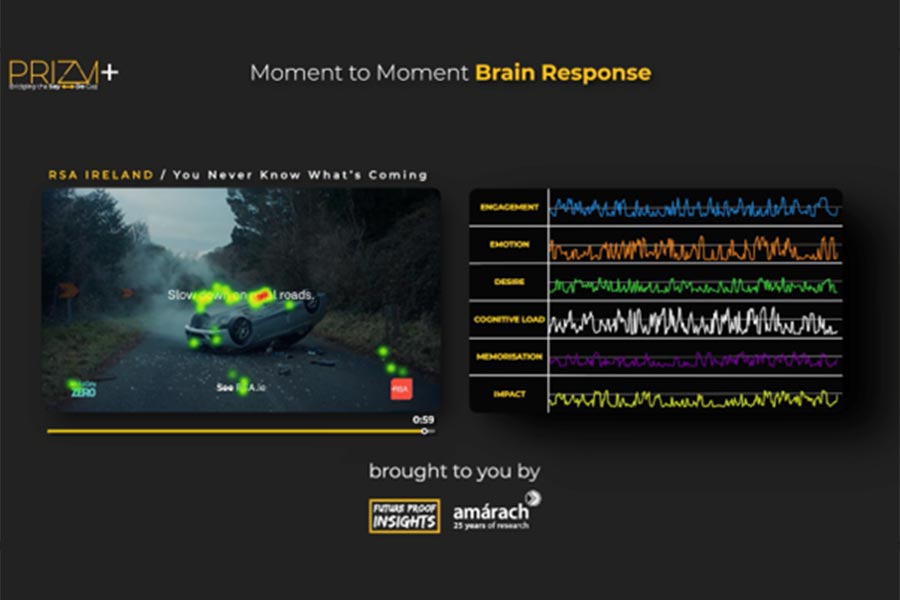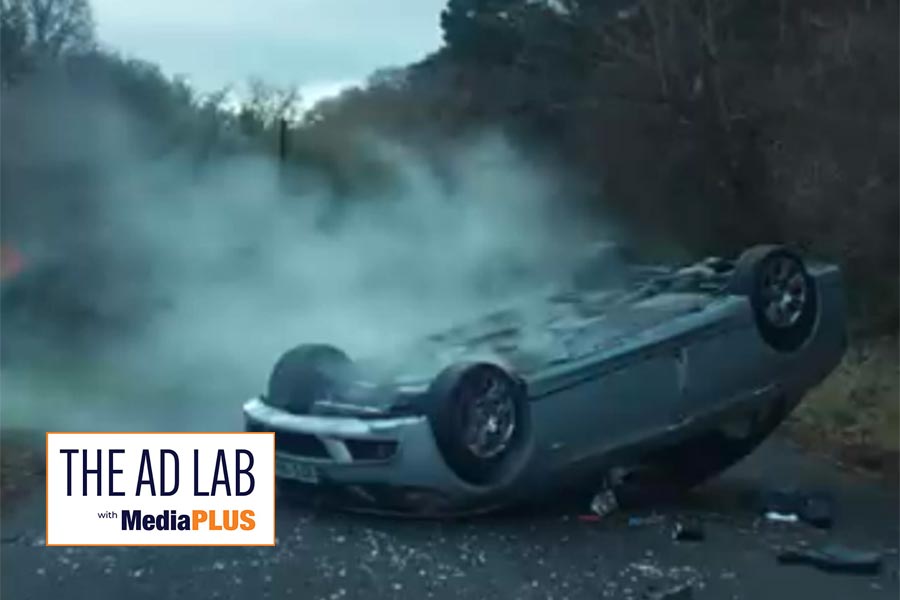Every week, Amárach and Future Proof Insights share exclusive findings from their PRIZM+ ad testing service, showcasing best practice creative advertising in Ireland.
Think about your favourite twist in a film, the kind that made the whole cinema go quiet for a beat.
You weren’t just reacting to what happened. You were reacting to your brain getting it wrong.
That moment is what psychologists call a prediction error. It happens when the brain confidently guesses what comes next, and then gets blindsided.
Whether it's the punchline to a joke or the reveal in a thriller, this disruption grabs attention and carves the moment into memory.
RSA’s campaign uses the very same mechanic to drive home an important message about speeding on rural roads.
Using a repetitive loop normality, the audience's brain identifies a monotonous pattern, that is abruptly torn down. The contrast doesn't just surprise. It sticks.
This is what is known as a "prediction error".
Our brains are fantastic at detecting patterns, these patterns help us make sense of the world around us and make the decisions and predictions that drive our behaviour.
When a familiar pattern is suddenly broken, it triggers a moment of heightened focus and emotional impact. RSA's campaign uses this effect deliberately.
By building a routine daily sequence, the ultimate crash interrupts that comfort, and that’s exactly why it lands so hard.
By showing the same daily routine over and over, the ad builds a rhythm and the viewer gets comfortable. And then it breaks it, with chaos followed by silence, to let it soak in.
That’s what makes the moment land and makes it memorable.
Neural Overview:
Our analysis of the audience's brain activity whilst watching the ad confirms that this strategy works.
Engagement and cognitive load fluctuate early on as the brain works to decode the repetition. But it’s the moment of impact, both literal and emotional, that triggers the biggest spike.
The "emotional interruption" leaves a mark. Memorisation jumps. Impact surges. And cognitive load falls sharply as the viewer narrows their focus to process what’s just happened.
This isn't passive viewing. It's felt.
High-Impact Scenes

Scene 4 (36–50s) — The Fateful Morning
The man wakes early. As in previous scenes, we see another slice of his morning routine, this time, sipping coffee and pausing to hold his child’s toy.
For the first time, there's a softness to his expression. Then, as he leaves the house and drives down the same rural road, gaining speed, he turns the familiar corner that we've been presented with several times already.
But this time something changes, he has veered across the lanes and as another car appears, he struggles to adjust and ultimately crashes his car.
The crash is abrupt. The screen cuts to black as we hear the vehicle continue to tumble down the road.

Why it worked: The viewer has been conditioned by the rhythm of routine. By this point in the ad, they’ve learned to expect more of the same, a predictable sequence of daily tasks, a familiar road, the same corner.
But just as the pattern feels fully cemented, it’s violently broken. The crash doesn’t just surprise; it disrupts expectation.
This jolt registers neurologically, emotional arousal spikes, memorisation lifts, and cognitive load drops as the brain focuses on the rupture.
It’s not just an event, it’s a sharp cognitive correction that anchors the message.
Scene 5 (52–60s) - “The Aftermath”
To close out the ad, we’re left with the wreckage, both physical and emotional. We see the damage done to the vehicle, confirming the fate of the driver.
But to really drive home the consequences of the wreckage, we are shown the driver's child's toy - laying on the ground in front of the destruction.
Emphasising the point that the driver isn't the only victim of this tragedy.
Then the key takeaway "Slow down on rural roads”.
Why it worked: This is a moment of conceptual closure, but the message is driven home at multiple layers. The viewer makes sense of what’s happened without needing to be told.
The proximity of the key takeaway to the damage reinforces the association in an impactful way. Presenting the message as the vehicle lays there in wreck builds strong associations between the potential risks and the behaviour.
The silence here is more than absence, it acts as a sonic contrast to the buildup, amplifying the emotional resonance of the moment.
Behavioural Impact
The RSA campaign doesn’t just leave a visual or emotional impression, it manages to stay with the viewer in a more meaningful way.
Even without prompting, many people who watched it could name the brand and describe the storyline.
The memory traces are strong, driven by the structure of the ad and the emotional weight of its conclusion.
When respondents were asked to match an unbranded frame of the ad to a brand, RSA stood out as one of the most correctly attributed.
This kind of brand-to-creative match is what we call "stickiness", and it's a strong signal that viewers not only paid attention but remembered who was speaking to them.
What’s perhaps most striking is how a serious, message-driven ad also motivated behaviour. While no product is being sold, the idea that people should “slow down on rural roads” clearly landed. Viewers felt this was not just an important message, but one that applied to them. That feeling of personal relevance is key to driving reflective motivation, and it came through here.
There’s always a trade-off in emotionally heavy work. Not everyone will find the ad ‘enjoyable’ in the traditional sense, and enjoyment scores reflected that. But that’s not the creative’s purpose. This wasn’t about charm or entertainment.
It was about hitting the viewer hard enough that the message doesn’t fade. And on that front, the behavioural evidence suggests it worked.
Demographically, the campaign resonated most strongly with middle-aged adults and parents, those more likely to relate to household routines and the emotional symbolism of children’s toys.
Final Thought: Lessons for Marketers
The campaign also leverages something deeper: pattern recognition. The brain is wired to detect repetition.
Across the early scenes, viewers begin to anticipate what will happen next. This is a form of cognitive fluency, the mind feels comfortable as it processes the loop. But when that expected rhythm is violently broken, the emotional response spikes.
It's a textbook case of "chaos with structure": a stable pattern disrupted at just the right time to trigger memorability.
For brands trying to land a behavioural change message, the takeaway is simple: Don’t just deliver information, build tension, break the pattern, and resolve with clarity. That’s what the brain remembers.
For more insights from PRIZM+ on how neuroscience drives advertising impact, visit:
www.futureproofinsights.ie/prizm-plus










